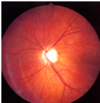Opthalmology Anatomy Flashcards

…

Orbital rim
Thin part of orbital rim?
What are they at risk of?
Complicatons of this?
Medial wall + orbital floor
* affected by orbital blowout fracture
* Comps: paraesthesia of skin of the face
How do eyelids protect the eyes? (4)
What do they contain? (4)
* Protect eyes: outer skin, inner conjunctiva, eyelashes, glands
* Contain: tarsal plate (maintains shape), meibomian glands (secrete lipids), obicularis oculi (CN7), levator palpabrie superioris (CN3, elevates upper eyelid)

…
Lacrimal gland innervation?
Function?
CN7 (parasympathetic)
* produces tears
Lacrimal apparatus?
* Lacrimal gland produces tears
* Pushed towards medial triangle
* drains through lacrimal puncta
* eventually reaches inferior meatus of nasal cavity


…
Layers of the eye? (3)
Fibrous - outer layer
* Sclera - white, fibrous
* Cornea - refraction
Uvea (vascular layer) - middle
* Iris
* Ciliary body - controls iris, shape of lens + aqueous humor secretion
* choroid - nutrition and gas exchange
Retina (photosensitive) - inner layer
Where is anterior segment of the eye?
Divided into? (2)
In front of lens
* anterior chamber = between cornea and iris, contains squeous humor
* Posterior chamber = between iris and suspensory ligaments, contaisn aqueous humor
Function of ciliary body of the eye? (3)
Where is it found?
Function
* controls iris
* shape of lens
* aqueous humor secretion
Found in uvea (middle layer)
Posterior segment of the eye?
Function?
Posterior segment is behind the lens, and makes up 2/3rds of the eye
* contrains vitreous body which secretes virteous humor (common place for “floaters”)
Describe circulation of aqueous fluid (4)
1) ciliary body
* secrete aqueous humor
2) aqueous circulates within posterior chamber and nourishes lens
3) squeous passes through pupil into anterior chamber, nourishes cornea
4) aqueous reabsorbed into scleral venous sinus (canal of Schlemm) at irodocorneal angle
Arterial supply to eye?
Opthalmic artery from internal carotid artery

What does the opthalmic artery divide into? (2)
Complication?
* Ciliary arteries + central artery of the retina
It is an end artery - cannot maintain tissue if occlusion occurs

Venous drainage of the eye? (2)
* Superior opthalmic vein drains into cavernous sinusvia superior orbital fissure
* Inferior opthalmic vein drains into superior opthalmic vein

Danger triangle of the face?
Infection in this area of the face can drain back into cavernous sinus and cause cavernous sinus thrombosis

Parts of the retina? (4)
Fundus
*posterior area where light is focused
Optic disc
* point of CN 2 formation
* only point of entry/exit of blood vessels + axons of CN2
* blind spot!!
Macula
* greatest density of cones
Fovea
* centre of macula
* area of most cute vision
Layers of the retina (from posterior to anterior)? (3)
Where do they retinal veins and arteries lie?
1) photoreceptors
2) ganglion cells
3) axons of ganglion cells
Retinal veins and arteries lie aterior to retina

Where is the blind spot of the eye?
Why?
Optic disc
* there are no photoreceptors in the optic disc

…
What does interruption of flow in retinal artery branch/vein cause?
What about interruption of flow in central artery (end artery)?
* loss of an area of visual field corresponding to area of ischaemia
* monocular blindness
Where is light from objects in the right visual field processed?
Lower visual field?
* Left primary visual cortext
* upper part of visual cortext
Extrinsic muscles of the eye? (6)
































































































